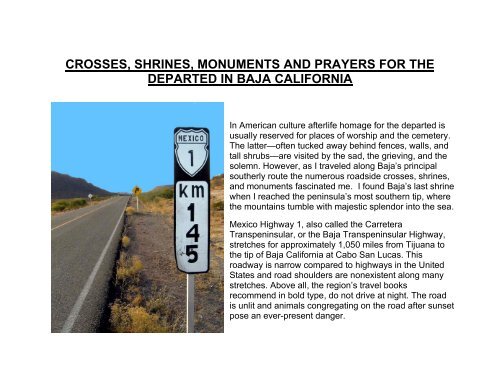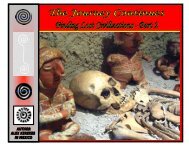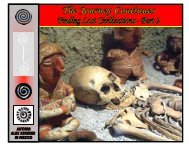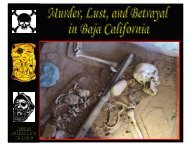crosses, shrines, monuments and prayers for the departed in baja ...
crosses, shrines, monuments and prayers for the departed in baja ...
crosses, shrines, monuments and prayers for the departed in baja ...
You also want an ePaper? Increase the reach of your titles
YUMPU automatically turns print PDFs into web optimized ePapers that Google loves.
CROSSES, SHRINES, MONUMENTS AND PRAYERS FOR THE<br />
DEPARTED IN BAJA CALIFORNIA<br />
In American culture afterlife homage <strong>for</strong> <strong>the</strong> <strong>departed</strong> is<br />
usually reserved <strong>for</strong> places of worship <strong>and</strong> <strong>the</strong> cemetery.<br />
The latter—often tucked away beh<strong>in</strong>d fences, walls, <strong>and</strong><br />
tall shrubs—are visited by <strong>the</strong> sad, <strong>the</strong> griev<strong>in</strong>g, <strong>and</strong> <strong>the</strong><br />
solemn. However, as I traveled along Baja’s pr<strong>in</strong>cipal<br />
sou<strong>the</strong>rly route <strong>the</strong> numerous roadside <strong>crosses</strong>, <strong>shr<strong>in</strong>es</strong>,<br />
<strong>and</strong> <strong>monuments</strong> fasc<strong>in</strong>ated me. I found Baja’s last shr<strong>in</strong>e<br />
when I reached <strong>the</strong> pen<strong>in</strong>sula’s most sou<strong>the</strong>rn tip, where<br />
<strong>the</strong> mounta<strong>in</strong>s tumble with majestic splendor <strong>in</strong>to <strong>the</strong> sea.<br />
Mexico Highway 1, also called <strong>the</strong> Carretera<br />
Transpen<strong>in</strong>sular, or <strong>the</strong> Baja Transpen<strong>in</strong>sular Highway,<br />
stretches <strong>for</strong> approximately 1,050 miles from Tijuana to<br />
<strong>the</strong> tip of Baja Cali<strong>for</strong>nia at Cabo San Lucas. This<br />
roadway is narrow compared to highways <strong>in</strong> <strong>the</strong> United<br />
States <strong>and</strong> road shoulders are nonexistent along many<br />
stretches. Above all, <strong>the</strong> region’s travel books<br />
recommend <strong>in</strong> bold type, do not drive at night. The road<br />
is unlit <strong>and</strong> animals congregat<strong>in</strong>g on <strong>the</strong> road after sunset<br />
pose an ever-present danger.
I have often heard that livestock can be found on Mexican highways after nightfall. Later, I learned that<br />
after sunset many animals seek asphalt roads because <strong>the</strong> pavement radiates <strong>the</strong> desert heat that has<br />
been absorbed dur<strong>in</strong>g <strong>the</strong> day. Animals are on <strong>the</strong> road dur<strong>in</strong>g <strong>the</strong> night to stay warm!
Along <strong>the</strong> roadway I saw several dead animals that had been killed by vehicles. These collisions often<br />
occur at a high rate of speed <strong>and</strong> end tragically <strong>for</strong> both <strong>the</strong> animal <strong>and</strong> driver. Without <strong>the</strong> benefit of a<br />
road shoulder, vehicles often careen off <strong>the</strong> highway, frequently with terrible results.<br />
At this accident site a horse apparently was st<strong>and</strong><strong>in</strong>g <strong>in</strong> <strong>the</strong> middle of <strong>the</strong> highway be<strong>for</strong>e it was struck.<br />
You can see <strong>the</strong> skid marks detail<strong>in</strong>g <strong>the</strong> po<strong>in</strong>t of impact <strong>and</strong> <strong>the</strong> vehicle’s route of travel. Fortunately,<br />
<strong>the</strong>re was a road shoulder.
Roadside memorials are called “descansos,” which means “rest<strong>in</strong>g place” <strong>in</strong> Spanish. Some believe that<br />
<strong>the</strong> practice of erect<strong>in</strong>g <strong>the</strong>se memorials (also referred to as “crucitas” or “memorias”) may have its<br />
orig<strong>in</strong>s <strong>in</strong> Mexico. The dictionary def<strong>in</strong>es “descanso” as a roadside marker or memorial to a victim of an<br />
automobile accident. But not all descansos are along highways; <strong>the</strong> practice also memoralizes <strong>the</strong> place<br />
where <strong>the</strong> soul left <strong>the</strong> body.
This descanso was erected with rocks from <strong>the</strong> surround<strong>in</strong>g area. Some researchers believe this<br />
practice comes from a Spanish tradition of plac<strong>in</strong>g stones where pallbearers rested between <strong>the</strong> church<br />
<strong>and</strong> <strong>the</strong> cemetery. Later <strong>the</strong> stones became <strong>crosses</strong>. An <strong>in</strong>terest<strong>in</strong>g aspect of descansos along Baja’s<br />
pen<strong>in</strong>sular route is that remnants of <strong>the</strong> accident’s wreckage are sometimes left alongside (or <strong>in</strong>cluded<br />
<strong>in</strong>) <strong>the</strong> descanso. Notice <strong>the</strong> car hood to <strong>the</strong> right of <strong>the</strong> stone memorial. More wreckage was strewn<br />
about <strong>the</strong> area, which seemed to be a very old site.
This descanso was created us<strong>in</strong>g <strong>the</strong> remnants of <strong>the</strong> “Green Angel” truck <strong>in</strong> which <strong>the</strong> driver met his<br />
untimely, violent end. Green Angels patrol Mexican highways to help motorists need<strong>in</strong>g mechanical<br />
assistance, tow<strong>in</strong>g, adjustment or chang<strong>in</strong>g of tires, travel <strong>in</strong><strong>for</strong>mation, first aid, <strong>and</strong> o<strong>the</strong>r assistance.<br />
Sometimes, even <strong>the</strong>se roadwise angels of mercy are rem<strong>in</strong>ded that no dispensation is offered to <strong>the</strong><br />
<strong>in</strong>attentive or careless traveler.
Although <strong>the</strong>re are many straight <strong>and</strong> level stretches along <strong>the</strong> Baja route, <strong>the</strong> roadway also follows <strong>the</strong><br />
dictates of <strong>the</strong> mounta<strong>in</strong>ous terra<strong>in</strong>. Consequently, <strong>the</strong>re are many 90 degree <strong>and</strong> severe S-turns on<br />
Mexico Highway 1. At almost every one of <strong>the</strong>se treacherous areas is a descanso.
This descanso rests at <strong>the</strong> bottom of a downhill, 90 degree curve. Notice <strong>the</strong> rock barrier erected to<br />
prevent vehicles from hurtl<strong>in</strong>g off <strong>the</strong> road. The brown object beh<strong>in</strong>d <strong>the</strong> <strong>crosses</strong> is a car door, most<br />
likely from <strong>the</strong> vehicle <strong>in</strong>volved <strong>in</strong> <strong>the</strong> fatality.
Beyond this S-turn are two descansos. The photograph on <strong>the</strong> right depicts a simple wooden cross <strong>and</strong><br />
a pile of stones to mark one spot. Note <strong>the</strong> side view mirror (no doubt a remnant of <strong>the</strong> wreck) that has<br />
been left on <strong>the</strong> stones.
Remnants of wreckage of a fatal accident are located beh<strong>in</strong>d shr<strong>in</strong>e <strong>and</strong> strewn around <strong>the</strong> area—<br />
testimony to <strong>the</strong> sudden <strong>and</strong> violent departure of <strong>the</strong> soul from <strong>the</strong> body. In <strong>the</strong> right-h<strong>and</strong> photo, note<br />
<strong>the</strong> wreath ly<strong>in</strong>g atop <strong>the</strong> wreckage.
Driv<strong>in</strong>g defensively is required <strong>in</strong> Mexico, accord<strong>in</strong>g to <strong>the</strong> country’s AAA tour book. “Always be alert to<br />
road conditions <strong>and</strong> o<strong>the</strong>r motorists. Bus, truck, <strong>and</strong> o<strong>the</strong>r drivers who are familiar with local routes will<br />
drive faster <strong>and</strong> negotiate maneuvers more boldly than tourists.” Driv<strong>in</strong>g <strong>in</strong> Mexico requires patience <strong>and</strong><br />
<strong>in</strong>tuition, <strong>and</strong> <strong>for</strong>eign drivers often f<strong>in</strong>d that <strong>the</strong> Mexican driv<strong>in</strong>g culture is far more complicated than <strong>in</strong><br />
<strong>the</strong>ir own home country. Local drivers tend to weave <strong>in</strong> <strong>and</strong> out of lanes as <strong>the</strong>y please, often without <strong>the</strong><br />
use of turn signals; <strong>the</strong>y also frequently ignore red lights or rive <strong>the</strong> wrong way on one-way streets. And<br />
so on. This photo shows a van pass<strong>in</strong>g a truck on a curve with a small cliff to <strong>the</strong> left as both vehicles<br />
head downhill on a mounta<strong>in</strong>ous road approach<strong>in</strong>g a 90-degree bl<strong>in</strong>d turn.
A fac<strong>in</strong>at<strong>in</strong>g th<strong>in</strong>g about <strong>the</strong>se Mexican roadside <strong>shr<strong>in</strong>es</strong> is that <strong>the</strong>y resemble gravesites. In American<br />
culture a gravesite identifies <strong>the</strong> f<strong>in</strong>al rest<strong>in</strong>g place of physical rema<strong>in</strong>s. But, as previously mentioned, a<br />
descanso <strong>in</strong> a spiritual context is <strong>in</strong>tended to memoralize <strong>the</strong> place where <strong>the</strong> soul left <strong>the</strong> body. The<br />
souls of Oscar, Rogelio, Gabriel, <strong>and</strong> Israel <strong>departed</strong> here on 25 May 1994. May <strong>the</strong>y rest <strong>in</strong> peace.
Descansos can sometimes be found on clear, level, <strong>and</strong> roadworthy sections of <strong>the</strong> highway without any<br />
h<strong>in</strong>t of <strong>the</strong> circumstances. Thomas Mann said, "A man's dy<strong>in</strong>g is more <strong>the</strong> survivor's affair than his own.”<br />
So families <strong>and</strong> friends place a cross on <strong>the</strong> site, build a shr<strong>in</strong>e, light c<strong>and</strong>les, lay wreaths, <strong>and</strong> pray <strong>for</strong><br />
<strong>departed</strong> souls—perhaps feel<strong>in</strong>g a little better know<strong>in</strong>g that <strong>the</strong> mournful place has been blessed.
And so at <strong>the</strong> f<strong>in</strong>al rest<strong>in</strong>g place <strong>the</strong> mourners mark <strong>the</strong> spot <strong>and</strong> bless <strong>the</strong> soil with holy water. They are<br />
com<strong>for</strong>ted know<strong>in</strong>g that <strong>the</strong> l<strong>in</strong>ger<strong>in</strong>g soul is on camposanto (holy ground) <strong>and</strong> that <strong>the</strong>ir <strong>departed</strong> will be<br />
remembered.<br />
Tibetan Buddhist say<strong>in</strong>g: “ When you are born, you cry, <strong>and</strong> <strong>the</strong> world rejoices. When you die, you<br />
rejoice, <strong>and</strong> <strong>the</strong> world cries.”
Along with <strong>the</strong> tradition of erect<strong>in</strong>g <strong>crosses</strong> is that of build<strong>in</strong>g roadside <strong>shr<strong>in</strong>es</strong>. The <strong>shr<strong>in</strong>es</strong>, which<br />
resemble small chapels (or, as shown here, a hollowed out s<strong>and</strong>stone boulder), provide a place to pull<br />
over to rest <strong>and</strong> pray <strong>for</strong> <strong>the</strong> protection of travelers. The <strong>shr<strong>in</strong>es</strong> are often dedicated to a particular sa<strong>in</strong>t,<br />
<strong>and</strong> <strong>in</strong>clude an altar filled with lit c<strong>and</strong>les, flowers, <strong>and</strong> religious folk art.
This shr<strong>in</strong>e, carved from a s<strong>and</strong>stone boulder is dedicated to <strong>the</strong> Virg<strong>in</strong> of Guadalupe.
The vehicle <strong>in</strong>volved <strong>in</strong> this fatality was a gray, 4x4 truck, <strong>in</strong>dicated by <strong>the</strong> fender lean<strong>in</strong>g aga<strong>in</strong>st <strong>the</strong><br />
descanso rail<strong>in</strong>g. More wreckage was strewn beh<strong>in</strong>d <strong>the</strong> shr<strong>in</strong>e.
Vidal Gonzalez S<strong>and</strong>oval. Born, 21 February 1970. F<strong>in</strong>al rest<strong>in</strong>g place, 16 December 2001.
There has been a fatality at almost every curve along <strong>the</strong> sierra (mounta<strong>in</strong>side) route. For <strong>the</strong> most part<br />
<strong>the</strong>re were appropriate roadway markers along <strong>the</strong> Baja route, but I never saw a Mexican highway<br />
officer dur<strong>in</strong>g my travels. The lack of police presence results <strong>in</strong> <strong>the</strong> rules of <strong>the</strong> road, speed, <strong>and</strong> safety<br />
precautions be<strong>in</strong>g self-regulated—<strong>and</strong> largely ignored. Consider<strong>in</strong>g human nature, my sense is that <strong>the</strong><br />
situation would be no different <strong>in</strong> <strong>the</strong> United States. Were it not <strong>for</strong> law en<strong>for</strong>cement, we would all be<br />
travel<strong>in</strong>g like madmen.<br />
Remnants of <strong>the</strong> wreckage related to this descanso can be seen to <strong>the</strong> left of <strong>the</strong> shr<strong>in</strong>e.
Elizabeth Felix. Born: 30 May 64. Fallen: 22 June 02. Descance En Paz – Rest In Peace
The 90-degree turns effect lanes of traffic <strong>in</strong> ei<strong>the</strong>r direction. There were descansos on both sides of this<br />
curve, almost opposite each o<strong>the</strong>r. Note <strong>the</strong> skid marks. The gully beh<strong>in</strong>d this cross is littered with<br />
vehicle wreckage.
Warn<strong>in</strong>g sign <strong>for</strong> an upcom<strong>in</strong>g 90-degree turn. See <strong>the</strong> wrecked guardrail. The remnants of several truck<br />
wrecks litter <strong>the</strong> slope. A lady <strong>in</strong> a red shirt at <strong>the</strong> left of <strong>the</strong> photo is lay<strong>in</strong>g a wreath alongside a<br />
descanso. There were three on this hillside.
Lean<strong>in</strong>g aga<strong>in</strong>st <strong>the</strong> cross <strong>in</strong> this memorial is a car door from <strong>the</strong> fatal crash. O<strong>the</strong>r remnants were<br />
strewn about <strong>the</strong> site.
This descanso was located on a straight <strong>and</strong> level part of <strong>the</strong> highway that ran through a small village.<br />
To slow traffic, speed bumps (known as “Topes”) are placed on <strong>the</strong> highway at a town’s entrance <strong>and</strong><br />
exit. It is always wise to slow down <strong>in</strong> <strong>the</strong>se areas; Topes are not always marked <strong>and</strong> can severely<br />
damage a vehicle travel<strong>in</strong>g at excessive speeds. Descansos are also erected <strong>for</strong> o<strong>the</strong>r types of fatalities,<br />
<strong>in</strong>clud<strong>in</strong>g those of pedestrians.
This descanso memorializes <strong>the</strong> f<strong>in</strong>al rest<strong>in</strong>g place of a truck driver. A computer search <strong>for</strong> Pena<br />
Truck<strong>in</strong>g yielded a list<strong>in</strong>g under getadriv<strong>in</strong>gjob.com. Al Pena Truck<strong>in</strong>g, Baja Cali<strong>for</strong>nia Norte, Mexico.<br />
Who, I wondered, replaced this driver?
The <strong>in</strong>scription reads, “In memory from your bro<strong>the</strong>rs, sisters, <strong>and</strong> cous<strong>in</strong>s.” The literal translation of <strong>the</strong><br />
word “recuerdo” is “souvenir.” However, <strong>in</strong> <strong>the</strong> context of a descanso it would be more appropriate to<br />
translate it as “<strong>in</strong> memory.”
A path from <strong>the</strong> highway led to this natural monument, which depicts <strong>the</strong> Virg<strong>in</strong> of Guadalupe. Below <strong>the</strong><br />
pa<strong>in</strong>t<strong>in</strong>g was an altar of natural stone on which many c<strong>and</strong>les were lit <strong>in</strong> homage or as an offer<strong>in</strong>g to<br />
travelers.
While st<strong>and</strong><strong>in</strong>g along one of Baja’s lonely stretches I thought about <strong>the</strong> unexpected, violent, <strong>and</strong> sudden<br />
deaths that had happened along this route. A quote from Proust came to m<strong>in</strong>d: “We say that <strong>the</strong> hour of<br />
death cannot be <strong>for</strong>ecast, but when we say this we imag<strong>in</strong>e that hour as placed <strong>in</strong> an obscure <strong>and</strong><br />
distant future. It never occurs to us that it has any connection with <strong>the</strong> day already begun or that death<br />
could arrive this same afternoon, this afternoon which is so certa<strong>in</strong> <strong>and</strong> which has every hour filled <strong>in</strong><br />
advance.”
This is Baja Cali<strong>for</strong>nia’s sou<strong>the</strong>rnmost monument, located at <strong>the</strong> high po<strong>in</strong>t of <strong>the</strong> Baja sp<strong>in</strong>e as it<br />
tumbles spectacularly <strong>in</strong>to <strong>the</strong> water where <strong>the</strong> Pacific Ocean <strong>and</strong> <strong>the</strong> Sea of Cortez meet. I climbed to<br />
this spot <strong>in</strong> 1989 while anchored <strong>in</strong> <strong>the</strong> small harbor of Cabo San Lucas after sail<strong>in</strong>g here from Newport<br />
Beach, Cali<strong>for</strong>nia.
The sou<strong>the</strong>rnmost tip of Baja Cali<strong>for</strong>nia. The Arches is one of <strong>the</strong> most dramatically beautiful meet<strong>in</strong>g<br />
places of l<strong>and</strong>, sea, <strong>and</strong> sky. This view is from <strong>the</strong> Sea of converge.
View from <strong>the</strong> Pacific Ocean. The town of Cabo San Lucas <strong>and</strong> its harbor comes <strong>in</strong>to view after sail<strong>in</strong>g<br />
around <strong>the</strong> Arch, where <strong>the</strong> Sea of Cortez converges.
Ano<strong>the</strong>r view from <strong>the</strong> western side, where <strong>the</strong> Pacific Ocean <strong>and</strong> <strong>the</strong> Sea of Cortez converge <strong>and</strong> Baja<br />
Cali<strong>for</strong>nia ends. Locally, this area is known as “Divorce Beach.”
Harvest moon over Cabo. I found Baja’s sou<strong>the</strong>rnmost descanso while climb<strong>in</strong>g through a cliff pass to<br />
where Baja Cali<strong>for</strong>nia, <strong>the</strong> Pacific Ocean, <strong>and</strong> <strong>the</strong> Sea of Cortez converge.
Baja Cali<strong>for</strong>nia’s sou<strong>the</strong>rnmost descanso located on <strong>the</strong> Pacific Ocean side of a cliff trail lead<strong>in</strong>g to a<br />
f<strong>in</strong>al meet<strong>in</strong>g of l<strong>and</strong> <strong>and</strong> sea.
The descanso was adjacent to a trail that was treacherous <strong>and</strong> threatened climbers with <strong>the</strong> potential of<br />
fall<strong>in</strong>g rocks <strong>and</strong> boulders. Patricia Ruiz. Born 1 Jan 1980, Died 1 Dec 2002.
Arriv<strong>in</strong>g safely at L<strong>and</strong>’s End. Are Mexican highways dangerous? In <strong>the</strong> United States <strong>the</strong>re are<br />
approximately 50,000 traffic fatalities a year. And <strong>in</strong> most cases, both <strong>in</strong> <strong>the</strong> U.S.A. <strong>and</strong> Mexico, <strong>the</strong><br />
primary factor <strong>in</strong>volved is human error, which <strong>in</strong>cludes driv<strong>in</strong>g too fast <strong>for</strong> road conditions, <strong>in</strong>attention,<br />
alcohol, <strong>and</strong> so <strong>for</strong>th. So be<strong>for</strong>e draw<strong>in</strong>g any conclusions about Mexico, consider first <strong>the</strong> universal law of<br />
karma: action <strong>and</strong> reaction, cause <strong>and</strong> effect, sow<strong>in</strong>g <strong>and</strong> reap<strong>in</strong>g.<br />
“In <strong>the</strong> course of natural righteousness, man, by his thoughts <strong>and</strong> actions, becomes <strong>the</strong> arbiter<br />
of his dest<strong>in</strong>y.” --Paramahansa Yogan<strong>and</strong>a







